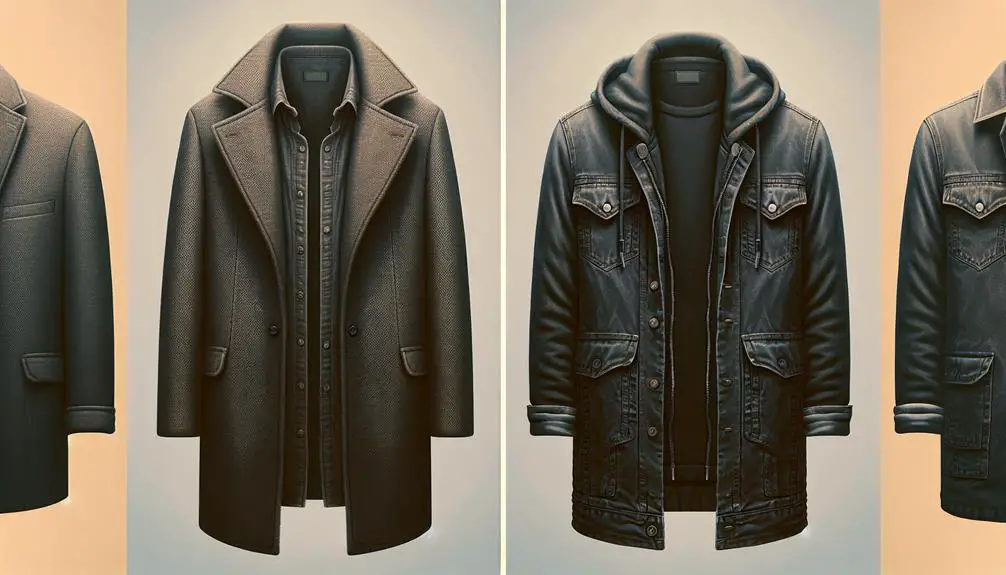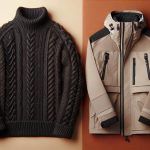I was surprised to learn that the average person owns around eight jackets but only two coats.
As I was organizing my outerwear collection, I paused to ponder the subtle yet significant differences between a coat and a jacket.
Understanding these nuances can elevate your style game and ensure you're appropriately dressed for any occasion.
So, next time you reach for your outer layer, consider the distinction between a coat and a jacket; it might just change how you approach your wardrobe choices.
Table of Contents
Key Takeaways
- Coats offer more warmth with longer lengths for colder climates.
- Jackets are versatile and shorter, suitable for trans-seasonal wear.
- Coats are heavier with insulating materials like wool, while jackets are lighter.
- Jackets are ideal for casual settings, while coats excel in formal occasions and harsh weather.
Key Differences Between Coat and Jacket
When choosing between a coat and a jacket, the key differences become apparent in their length, insulation, and suitability for specific weather conditions. Coats are the go-to choice for colder climates, offering longer lengths that provide extra warmth and coverage. They're crafted from heavier fabrics and boast more insulation compared to jackets, making them ideal for harsh winter conditions.
On the other hand, jackets are shorter in length, typically stopping at the waist or hips. They're constructed with lighter materials, offering versatility for trans-seasonal wear when the weather isn't too extreme. Jackets come in a variety of styles such as bombers, denim, and parkas, catering to different fashion preferences.
In contrast, coats include options like trench coats and peacoats, known for their classic and sophisticated look. Understanding these distinctions is essential in selecting the right outerwear to stay comfortable and stylish in various weather conditions.
Fabric and Insulation Variances
Moving from the distinction between coats and jackets, let's now explore the fabric and insulation variances that play a crucial role in determining the suitability of outerwear for different weather conditions.
- Coats are typically made using thicker and heavier materials such as wool, down, or fur, providing more warmth in severe cold compared to jackets. These fabrics are designed to offer superior insulation levels, making coats heavier than jackets but ideal for harsh winter climates.
- In contrast, jackets feature lighter-weight fabrics, often synthetic or blended materials, which are less insulating than the ones used in coats. This lighter construction makes jackets more versatile for milder weather conditions or as layering pieces during transitional seasons.
- The insulation levels in coats are strategically higher to ensure better protection against extreme cold, while jackets prioritize a balance of comfort and style without compromising on functionality. Understanding these fabric and insulation distinctions can help you choose the right outerwear for specific weather demands.
Length and Fit Distinctions
Length and fit distinctions play a significant role in defining the differences between coats and jackets, influencing both the coverage and style of outerwear pieces. Coats are typically knee-length or thigh-length, providing more warmth and insulation compared to jackets. Their long sleeves offer better protection against cold weather.
In contrast, jackets are waist-length or hip-length, designed for a more casual and versatile look. Jackets usually offer a snug fit, making them suitable for layering or as standalone pieces in milder conditions.
When it comes to fit, jackets are often tailored for a more body-hugging silhouette, while coats may have a more relaxed or structured fit. Belts are commonly used with coats to cinch the waist, providing added warmth and a tailored appearance, a feature not typically found in jackets.
Understanding these length and fit distinctions can help you choose the right outerwear piece based on your needs for warmth, style, and layering options.
Style and Versatility Factors
When deciding between a coat and a jacket, it's essential to consider the style versatility each offers. Jackets are great for mixing and matching with different outfits, while coats often bring a formal touch to your look.
Understanding how to layer and style these pieces can elevate your fashion game for any occasion.
Style Versatility Comparison
Considering the various style options available, jackets offer a more versatile and trendy appeal compared to coats.
Style Versatility of Jackets:
- Casual to Semi-Formal: Jackets like denim, bomber, and leather offer a stylish edge perfect for casual and semi-formal occasions.
- Easy Dressing Up or Down: Jackets can be effortlessly styled up or down, making them adaptable for various events.
- Trendy Touch: Jackets add a trendy touch to outfits, allowing for creative and personalized styling options.
Jackets stand out for their adaptability and trendy appeal, making them a versatile choice for those looking to make a fashion statement.
Occasion-Appropriate Outerwear Choices
For selecting the perfect outerwear to match any occasion, it's essential to consider the style and versatility factors offered by both jackets and coats.
A denim jacket is a fantastic choice for casual outings, adding a trendy touch to your ensemble. On the other hand, a trench coat is perfect for formal events, exuding sophistication and style.
When braving the winter chill, a winter coat will keep you warm during outdoor activities while still looking fashionable. Jackets excel in versatility for rainy days, travel, and everyday wear, while coats shine at business meetings and evening dinners.
Layering Options for Fashion
To effortlessly elevate your fashion game, embrace the art of layering with jackets for a versatile and stylish wardrobe.
- Mix and Match: Pair a denim jacket with a dress for a casual yet chic look that exudes effortless style.
- Trench Time: Opt for a classic trench coat as a versatile layering piece that transitions seamlessly from day to night.
- Personal Touch: Experiment with different textures and colors to showcase your personal style through creative layering combinations.
Weather Suitability Considerations
When deciding between a coat and a jacket, it's crucial to factor in the weather suitability to ensure comfort and practicality. Jackets are more suitable for milder weather conditions like late spring, summer, and early fall due to their lighter weight and less insulating properties. They're ideal for casual events, rainy days, casual outings, and traveling, offering versatility and style in various weather conditions.
On the other hand, coats are best worn during late fall, winter, and early spring as they offer more warmth and protection against colder temperatures. Coats are perfect for winter weather, business meetings, evening dinners, outdoor formal occasions, and stylish layering to stay warm and fashionable. For extreme cold and harsh weather conditions, parkas are recommended, providing superior insulation and protection.
Understanding the weather conditions and the warmth needed will help you choose between jackets and coats for the most suitable outerwear.
Layering Potential of Coats and Jackets
Considering the layering potential of coats and jackets, it becomes evident that each offers unique advantages for creating stylish and functional outfits.
- Coats: Coats are ideal for layering thanks to their longer length and heavier fabrics. They provide excellent insulation and protection against harsh weather conditions, making them perfect for cold climates.
- Jackets: Jackets, on the other hand, offer versatile layering options with lighter weight materials and various styles. They can be easily paired with different clothing pieces to create a range of looks suitable for changing temperatures.
- Mix and Match: By mixing and matching coats or jackets with different textures and lengths, you can achieve unique layered looks for various occasions. Layering a coat over multiple clothing layers enhances warmth, while jackets can be effortlessly styled with sweaters or hoodies for added comfort and flair. Experimenting with combinations allows you to express your personal style while staying cozy and fashionable.
Occasions for Wearing Coats Vs Jackets
Exploring the occasions suited for wearing coats versus jackets reveals the versatility and style options each garment brings to various settings and events. Coats are a go-to choice for winter weather, formal gatherings, business meetings, and outdoor activities where extra warmth and sophistication are paramount. Their ability to provide protection from harsh winter conditions makes them essential for staying both stylish and cozy.
On the other hand, jackets shine in more casual settings, during travel, on mild rainy days, and as a versatile layering piece for a range of activities. They offer insulation suitable for colder but not extreme weather, making them a practical choice for everyday wear. When deciding between a coat or jacket, consider the event and weather conditions; coats elevate elegance and formality, while jackets offer a blend of practicality and style that suits a variety of occasions.
Whatever the weather or occasion, there's a perfect choice between coats and jackets to keep you both comfortable and fashionable.
Maintenance and Care Requirements
Taking care of your coat or jacket is essential to keep it looking its best. Cleaning instructions and storage tips can vary depending on the fabric and design of your garment.
Let's explore how to maintain and care for your outerwear to ensure it lasts for seasons to come.
Cleaning Instructions
To properly care for your coat or jacket, always adhere to the care label instructions provided for specific cleaning guidelines. When it comes to outerwear cleaning, it's essential to follow these fabric care tips:
- Consider dry cleaning delicate fabrics like wool, fur, or leather to maintain their quality and prevent damage.
- Machine wash jackets made of durable materials such as denim or cotton on a gentle cycle to avoid unnecessary wear and tear.
- Use a mild detergent to clean your outerwear and avoid harsh chemicals that could potentially damage the fabric. Remember to air dry your coat or jacket to prevent shrinkage or damage from the high heat of a dryer.
Storage Tips
Storing your coats and jackets properly is essential to maintain their quality and prevent damage over time. When it comes to storing these garments, consider the fabric, hangers, and the use of garment bags. Here are some tips for keeping your coats and jackets in top condition:
| Tip | Description |
|---|---|
| Store in a cool, dry place | Prevents mold and mildew growth. |
| Use sturdy, padded hangers | Maintains shape and prevents wrinkles. |
| Avoid plastic bags | Allows the fabric to breathe and prevents musty odors. |
| Consider garment bags for long-term storage | Protects from dust and pests. |
Fashion Trends Impacting Coat and Jacket Choices
Fashion trends actively shape the choices individuals make when selecting coats and jackets, influencing preferences towards specific styles like oversized puffer jackets or tailored wool coats.
- Sustainable fashion movements have transformed the coat and jacket landscape, encouraging the use of eco-friendly materials and ethical production practices, aligning fashion with environmental consciousness.
- Celebrity endorsements and influencer collaborations wield significant influence, propelling certain coat and jacket designs into the spotlight and driving consumer interest.
- Cultural influences and runway trends serve as pillars in the fashion industry, dictating the styles to choose from and reflecting societal shifts in tastes and preferences.
These elements showcase how the coat and jacket market isn't just about warmth and functionality but also about keeping up with the dynamic world of fashion. By understanding these trends, individuals can make informed decisions that align with their personal style while staying current and conscious of the broader fashion landscape.
Frequently Asked Questions
Is a Coat and Jacket the Same Thing?
No, a coat and jacket are not the same thing. They differ in length, weight, and insulation. A coat provides more warmth and coverage, while a jacket is lighter and more versatile, typically stopping at the hip or waist.
Can a Coat Be a Jacket?
Yes, a coat can be considered a type of jacket. The distinction can be based on factors like length, warmth, and style. However, the terms are often used interchangeably based on regional and stylistic differences.
Why Are Coats Called Jackets?
So, why are coats called jackets? It's a classic case of regional quirks and fashion fusion. In some places, we just like to mix things up linguistically. It's all about style and semantics!
Do You Say Coat or Jacket?
I usually say "jacket" for shorter, lighter outerwear and "coat" for longer, warmer options. The choice depends on weather and occasion. Jackets are more versatile, while coats offer additional coverage. Deciding between them is about practicality and style.
- Why Is Red Velvet Not Red? - April 25, 2024
- How Do You Describe Velvet Fabric? - April 25, 2024
- How Strong Is Velvet? - April 25, 2024







